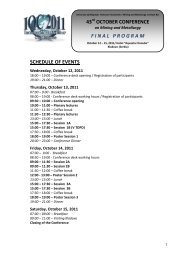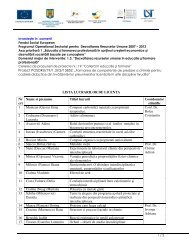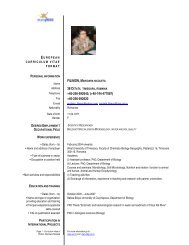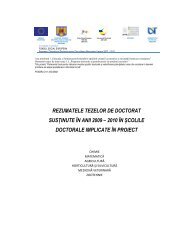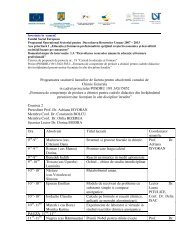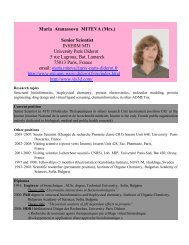Download PDF
Download PDF
Download PDF
You also want an ePaper? Increase the reach of your titles
YUMPU automatically turns print PDFs into web optimized ePapers that Google loves.
L EDEŢ I I.V., B ERCEAN, V.N.<br />
complexes with interesting properties [1].<br />
Metal complexes derived from transition metals are known for their antibacterial,<br />
insecticidal and pesticidal activities [2]. 1,2,4-Triazole ligands are an important class of<br />
compounds, that are used in modern analytical chemistry for the dosage of heavy-metals<br />
from waste waters using spectrophotometric methods [3,4]. Also, the triazolic nucleus is<br />
widely used in well-known pharmaceuticals (like Fluconazole, Itraconazole, Voriconazole,<br />
Terconazole etc.)[5], and in the synthesis of new bio-active agents [6-11].<br />
MATERIALS AND METHODS<br />
The reagents were commercial products (Merck, Fluka, Aldrich) and used without<br />
further purification, except compound 1a was prepared by an original method, mentioned in<br />
our previous studies [12]. Melting points were determined on a Boethius PHMK (Veb<br />
Analytik Dresden) instrument, and thin-layer chromatography was carried out on silica gelcoated<br />
plates 60 F 254 Merck using benzene: methanol 7:3, benzene: methanol 3:7 or<br />
benzene: ethyl acetate 1:1 (v/v) as eluents. IR spectra were recorded in KBr pellet on a<br />
Jasco FT/IR-410 spectrophotometer.<br />
Synthesis of ligand (1b) (LNa): sodium salt of 4H-4-amino-5-<br />
carboxymethylsulfanyl-3-phenyl-1,2,4-triazole<br />
To a suspension of 4H-4-amino-5-carboxymethylsulfanyl-3-phenyl-1,2,4-triazole<br />
(1a) (10.00 g, 40 mmol) in distilled water (50 mL), a NaOH 1M solution is added (40.0<br />
mL). The suspension is heated and maintained at 40 o C for 2h, and then the clear, colourless<br />
formed solution is purified with active charcoal. After filtration, the solution was cooled at<br />
r.t. and the solvent was removed by distillation under reduced pressure (10 mm Hg). The<br />
white-crystalline product (1b) (chromatographically pure) was used for the synthesis of the<br />
metal complexes.<br />
The syntheses of metal complexes of Cd 2+ and Cu 2+ with sodium salt of 4H-4-<br />
amino-5-carboxymethylsulfanyl-3-phenyl-1,2,4-triazole (LNa)<br />
The ligand LNa (1b) (0.709g, 26 mmol) was dissolved, under stirring, in distilled<br />
water (6 mL), when a colourless solution was formed. Separately, transition metal salts (13<br />
mmol, corresponding to 0.476g CdI 2 and 0.221g CuCl 2·2H 2 O respectively) were dissolved<br />
in distilled water (2.5 mL). The aqueous solution of ligand (1b) was added dropwise under<br />
intense stirring to the metal salt solution, and a coloured suspension was obtained instantly.<br />
All the suspensions were maintained under stirring for approx. 2h, then filtered off under<br />
vacuum and washed with distilled water (20 mL). The products (2,3) were dried in an oven<br />
at 80 o C for 72h.<br />
88




